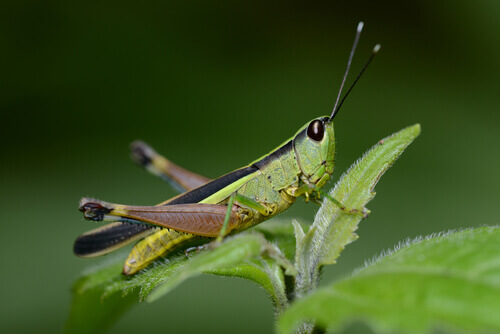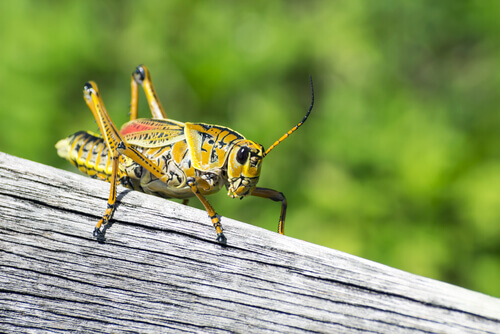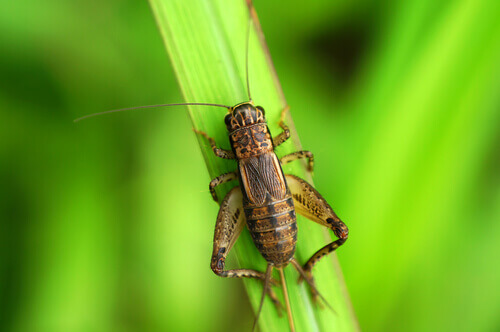The Cricket: Is It a Pest or Good Luck?

Is the cricket a pest or good luck? We could say that the answer to that question depends on the quantity. If you see a cricket in your window singing to the moon, you may think it’s a sign of good fortune. But, if you notice that a group of 30 crickets is eating the plants in your garden, you’ll consider them a pest! We’ll tell you about both perspectives in the following article.
Is the cricket a pest or good luck?
Crickets as a sign of good luck
Crickets have played a very important role in Asian cultures – especially in Japan and China – and in North American cultures. People have considered them to be a symbol of good luck, fortune, prosperity, and vitality.
There are many songs and stories about the cricket as a talisman of wisdom. Many Asians revered their song, placing them in small cages in order to ‘appreciate’ their sounds.
It was also common to say that this insect was a better guardian for a house than a dog because when it detected something ‘bad’, it stopped singing immediately. For this reason, artisans carved amulets in wood or stones with the figure of the insect, with the aim of protecting those who carried it with them.
Of course, we can’t forget to mention the fact that people eagerly awaited it before the rains, which would define a good harvest in the fields. Some farmers wouldn’t prepare their crops until they heard the famous song of this species whose scientific name is Gryllidae.
Do you know how this green animal ‘sings’ or emits sounds? It rubs its wings together. When do they do it? For one, when the male wants to find a mate. In other cases, it’s to indicate that this is its territory if an enemy approaches.

They’re also known as a symbol of prosperity because the females lay thousands of eggs each season. Tradition indicates that a family – or a woman – that has several children is successful.
Among Native American peoples, the cricket represents faith, joy, and intuition. Because of its ability to jump very high (thanks to its long legs), many associate it with the ability to get out of a difficult situation.
One legend states that the gods sent crickets to earth to remind us to be happy in spite of everything. If you see a cricket in your kitchen, it will bring fortune to your home. But be careful, because if you kill it, you’ll have bad luck for a whole season. Just in case, don’t try it!
The cricket as a pest
If we’re going to debate whether the cricket is a pest of good luck, we need to look at the flip side. Let’s leave aside for a moment the traditions and legends to move on to something a little more rational. That is, the fact that crickets can be a very dangerous pest for our gardens, orchards, or fields.
Due to their great capacity to reproduce and feed, from one day to the next, they can become a nightmare, even indoors. It’s good to know that they prefer warm and humid places, where they lay their eggs and can feed without problems.

While they don’t pose a health risk to people or pets, crickets can be very destructive to crops and gardens. The same is true regarding flour, grain, paper, and fabric storage.
You can prevent crickets by sealing windows, doors, or any other space through which they may gain access. In addition, you should mow the lawn around the house, clean gutters, avoid woodpiles, and check drains.
Since crickets – like many insects – are attracted to lights, opt for a dimmer type of lighting, such as LED bulbs with a ‘warm’ light, and don’t forget to close blinds and windows tightly at nighttime.
So, what do you think? Is the cricket a pest or good luck?
All cited sources were thoroughly reviewed by our team to ensure their quality, reliability, currency, and validity. The bibliography of this article was considered reliable and of academic or scientific accuracy.
- Aguirre-Segura, A., & Barranco, P. (2015). Clase Insecta. Orden Orthoptera. Revista IDEA-SEA, 46, 1-13. http://sea-entomologia.org/IDE@/revista_46.pdf
- Amateur Entomologists’ Society. (s.f.). Grasshoppers and crickets (Order: Orthoptera). Recuperado el 9 de mayo de 2023 de https://www.amentsoc.org/insects/fact-files/orders/orthoptera.html
- Costa, E. (2006). Cricket singing means rain: semiotic meaning of insects in the district of Pedra Branca, Bahia State, northeastern Brazil. Anais de Academia Brasileira de Ciencia, 78(1). https://www.scielo.br/j/aabc/a/cFvgDZ5MrSrjn3B6fND8g7L/?lang=en
- Magara, H. J. O., Niassy, S., Ayieko, M. A., Mukundamago, M., Egonyu, J. P., Tanga, C. M., Kimathi, E. K., Ongere, J. O., Fiaboe, K. K. M., Hugel, S., Orinda, M. A., Roos, N., & Ekesi, S. (2021). Edible Crickets (Orthoptera) Around the World: Distribution, Nutritional Value, and Other Benefits-A Review. Frontiers in nutrition, 7, 537915. https://www.ncbi.nlm.nih.gov/pmc/articles/PMC7835793/
- Palma, M., & Jeysonn, M. (2012). Control del grillo topo Scapteriscus abbreviatus (Orthoptera: Gryllotalpidae) en el cultivo de tomate (Lycopersicum esculentum), en la comunidad de Mascarilla, cantón Mira, provincia del Carchi, Ecuador. [Tesis de grado, Escuela Agrícola Panamericana Zamorano]. https://bdigital.zamorano.edu/server/api/core/bitstreams/446524dc-0695-48b4-9104-886bad8ff36f/content
- Sultana, S., Sanam, S., Kumar, S., Mohammad, S., & Soomro, F. (2021). A review of Gryllidae (Grylloidea) with the description of one new species and four new distribution records from the Sindh Province, Pakistan. Zookeys, 1078, 1-33. https://zookeys.pensoft.net/article/69850/
- Van Huis, A. (2022). Cultural significance of locusts, grasshoppers, and crickets in sub-Saharan Africa. Journal of Ethnobiology and Ethnomedicine, 18,24. https://link.springer.com/article/10.1186/s13002-022-00524-w